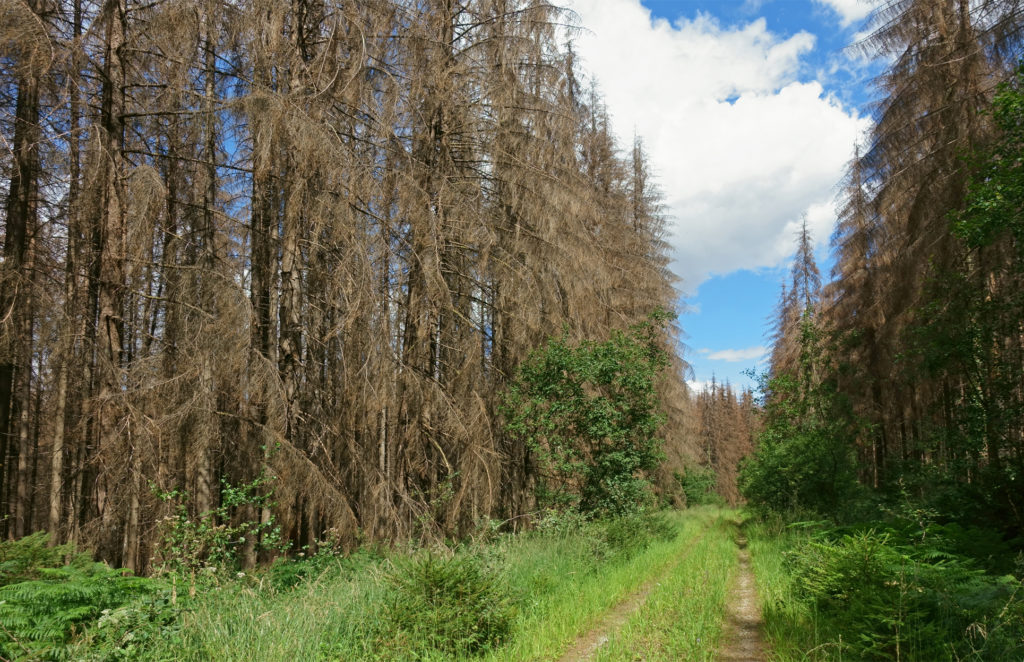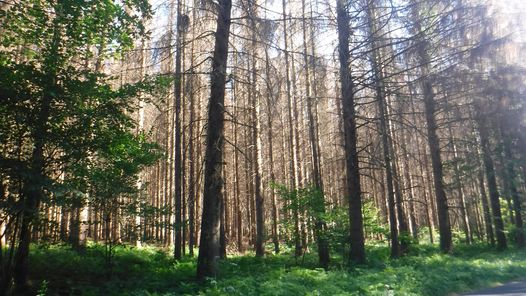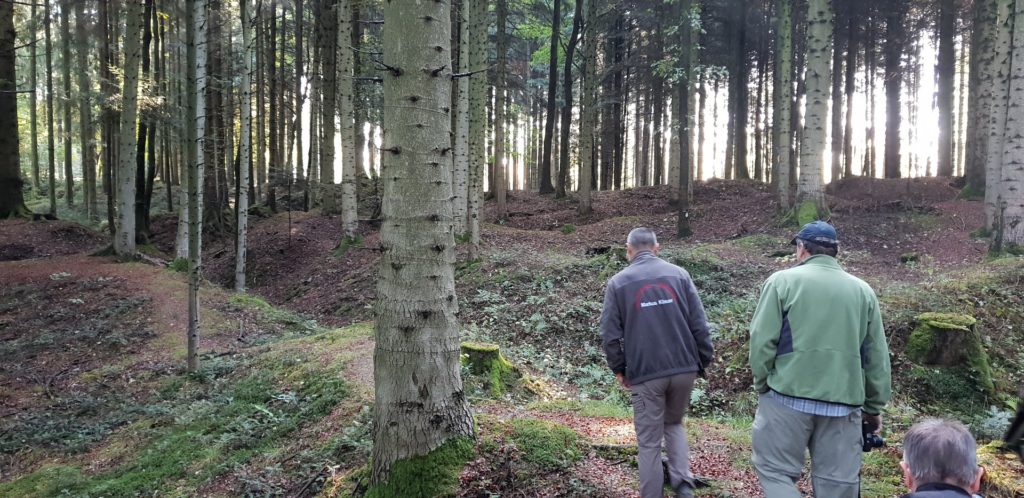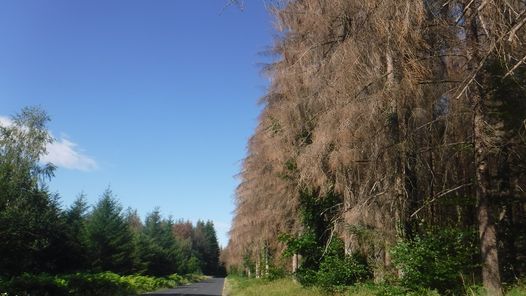Over the last year or so a new battle has been raging in Europe’s forests: A fight against the bark beetle (French: Scolyte); and this battle will have huge implications for portions of the WW1 Western Front and other battlefields as we know them today. In the words of historian and battlefield tourist, Wim Degrande, “We sure are going to see, in quite some sectors, a different Argonne Forest the next two years… you and I are lucky to have done so many visits the last 15 – 20 years.”
Bark beetles are nothing new—in Europe or in the United States. According to a U.S. Department of Agriculture website, “Bark beetles are tiny insects with hard, cylindrical bodies that reproduce under the bark of trees… Several species, such as the mountain pine beetle (Dendroctonus ponderosae), attack and kill live trees… During the past decade in the west, tree mortality caused by bark beetles has increased in spruce, lodgepole, pinyon-juniper, and ponderosa forests. This increase is correlated with shifts in temperature and increased water stress, which create conditions within trees that are favorable to beetle survival and growth.” (https://www.fs.fed.us/research/invasive-species/insects/bark-beetle.php)
This is exactly what is happening in Europe. Hot spring and summer temperatures and less rain, along with warmer winters, have made the bark beetle more of a menace than in the past. It seems to have hit especially hard in the “Grand Est” Region of France, which includes the battlefields of the Aisne, Argonne, Verdun, St. Mihiel and the Vosges; but it is also present in Belgian and German forests, including the Black Forest, and elsewhere.
Unfortunately, there is little that foresters can do to stop the menace. The French ONF (Office National des Forêts) is applying a strategy called l’abbatage (English: slaughter); removing infested trees as quickly as practical and, over time, replacing them with trees that are more resistant to bark beetles. It appears that the infestation is worst in Spruce trees, so foresters are concentrating on the parcels of land with large populations of Spruce trees. However, it is likely that they will have to remove other tree species over time as well. A short French video highlighting the issue and strategy can be seen here: https://www.youtube.com/watch?v=7iiTl8gieBI.
What follows are a few reports from European historians and battlefield visitors focusing on the Argonne Forest, in particular:
From Wim Degrande: “I was in the Argonne very recently, to check the actual state and forestry work that is going on, due to that scolyte disease. You also have seen pictures passing by on FB and internet I suppose. Nevertheless, I did not think it was that bad. Whole areas are already looking like a lunar landscape and much more wood needs to disappear. I ended my short day walking up to the Pionier 16 cemetery area on St. Hubert, and that’s where one gets silent… Thousands of trees dead. The whole area, and it’s a big area, is dead. I have not checked the Gruerie [Bois de la Gruerie] area for example or the region near Binarville, but we are going to see, in quite some sectors, a different Argonne Forest the next 2 years (no idea how the forest work will evolve). Some areas will be lost for about 20 years, until they become “visitable” again. It’s a big (climate) problem…”

Wim’s use of the word “some” reflects the reforestation of the Zone Rouge in the late 1920-30s. The Zone Rouge was an area of land deemed so poisoned or damaged by the war that it was unsuitable for farming or housing. The French ONF was tasked with letting nature help the recovery by planting Beeches, Spruces, Sycamore Maples, Ashes and Black Pines in various mixes and configurations. Fast forward to today, and it is the Spruces that are being ravaged most by the bark beetle.
Historian and author Christina Holstein provided a similar report of her recent visit along with some excellent photos on a Knee Deep Into History Facebook Group post recently. Photos from her drive along the D-67 (the Varennes – le Four-de-Paris Road) were used in this blog post.

Mr. Embry, President of the Comité Commémoratif de l’Argonne, the Association which maintains the Ossuaire de la Haute Chevauchée, summarized a meeting with the ONF in an August 24 Facebook post, stating: “…unfortunately both sites [the Ossuaire and the Ravin du Genie, maintained by another association] will see their landscape change greatly, but this is a necessary evil for the sustainability of conifers that are not yet affected and for everyone’s safety. The majority of the softwoods on both sides of the Ossuary Monument, as well as those behind the Pilgrim’s Shelter will be removed. The two plots we own [as opposed to National Forest property] are pretty low impacted, even though 16 spruce will still have to be cut down…”
But it is not just a problem in the forests. Bruce Malone, Superintendent of the Meuse-Argonne American Cemetery in Romagne-sous-Montfaucon, recently commented on Facebook that the cemetery has already cut down a few dozen trees, and he expects additional cuttings soon.
There are many ramifications of this infestation and the efforts to combat it: Worst, in my opinion, is the likely damage that heavy equipment will do to the remaining trenches, bunkers and tunnel systems in the area. The intentional re-forestation of Zone Rouge areas by France in the 1920-30s helped to preserve some wonderful examples of WW1 trench warfare on the Western Front. Various preservation groups on FB have reported recent or upcoming meetings with foresters in an effort to emphasize the archeological value these sites; but how much can be preserved without significant damage? At the time this article was written, one historical preservation association posted photos on Facebook showing the removal of signage, benches, etc. in advance of forestry work. (Again, one positive is that multiple species of trees were planted in the initial reforestation, so many areas remain less impacted.)
Second is the potential restricted access to the areas by visitors. During removal of trees there is little access to the area. But what about after new trees are planted? Will large sections of the Argonne Forest and other forests be restricted?
Third is the danger of exploring this area. Christina Holstein wisely told the author that the many dead trees pose a danger to battlefield explorers, especially during high winds or unfavorable weather.
Fourth is the economic impact to the region. The Department of the Meuse’s key industries are Forestry, Farming and Tourism. (I am not sure in which particular order.) The bark beetle has impacted forestry in two ways: The amount of harvestable lumber per damaged tree is reduced, and the sharp increase in harvested lumber has driven up supply and reduced prices significantly. This adds another issue for a region already suffering from reduced tourism due to Covid-19.
Being the optimist, I would hope that many of the WW1 remains in the Grand Est Region of France will survive. But, like Wim, I am glad that I had the opportunity to visit it so many times in the past.


Leave a Reply